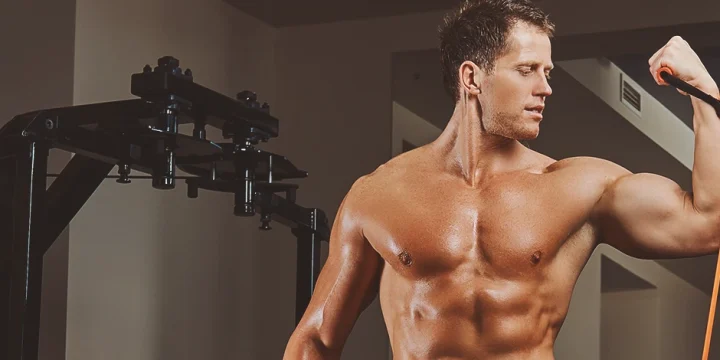Professional bodybuilders pay a lot of attention to striking the right balance between push and pull movements in their workout splits.
And as a certified personal trainer, I always try to get my general fitness and amateur bodybuilding clients to start thinking in the same way.
To help our readers with this same thought process, I got together with five other personal trainers, and we put together a push-pull training split. We also tested this for a month with a few clients to see how effective it is.
Here’s what we found.
Quick Summary
- A balanced push-pull workout split, incorporating compound movements like bench presses and rows, is optimal for muscle gain.
- For optimal results, consistently focus on progressive overload, vary intensity with proper form, and ensure adequate rest.
- A study from the National Institute of Health shows that the muscles in the upper body used for pushing are about 1.5–2.7 times stronger than the muscles involved in pulling.
- As a fitness trainer, I recommend clients explore a natural supplement stack, considering options that enhance performance and complement the perfect blend of push and pull movements for an improved fitness experience.
The Best 4 Push Pull Workout Split

To achieve an effective push-pull workout split, consider incorporating the following tested workouts with clients:
1. Upper Body Push
On the first day, focus on your arms, chest, shoulders, and back with challenging push exercises. Load up the weight for the following exercises and feel the burn quickly:
- Bench press (3 sets of 8-12 reps)
- Overhead press (3 sets of 8-12 reps)
- Dips (3 sets of 8-12 reps)
- Cable flyes (3 sets of 8-12 reps)
- Lateral raises (3 sets of 8-12 reps)
- Triceps extensions (3 sets of 8-12 reps)
2. Upper Body Pull

Now, transition to pull exercises, focusing on different muscles during the first upper body training day:
- Chin-ups (3 sets of 8-12 reps)
- Bent-over rows (3 sets of 8-12 reps)
- Barbell shrugs (3 sets of 8-12 reps)
- T-bar rows (3 sets of 8-12 reps)
- Biceps curls (3 sets of 8-12 reps)
- Reverse flys (3 sets of 8-12 reps)
3. Lower Body Push
This training day focuses on building your legs, glutes, and core with exercises designed to challenge your muscles:
- Dumbbell lunges (3 sets of 8-12 reps)
- Front squats (3 sets of 8-12 reps)
- Calf raises (3 sets of 8-12 reps)
- Leg extensions (3 sets of 8-12 reps)
- Hack squats (3 sets of 8-12 reps)
4. Lower Body Pull

In the concluding phase of our four-day split, focus on lower-body pull exercises:
- Romanian deadlifts (3 sets of 8-12 reps)
- Leg curls (3 sets of 8-12 reps)
- Hip thrusts (3 sets of 8-12 reps)
- Barbell good mornings (3 sets of 8-12 reps)
Read more: Chris Bumstead Push Pull Legs Routine for Proven Muscle Gains
How To Plan a Push Pull Workout Routine
To plan a push-pull workout routine, start by creating a list of push and pull exercises for both your upper and lower body.
Avoid random selection for different training days; instead, adopt a targeted approach with four specific training days.
According to research from the National Institute of Health, when aiming for hypertrophy, it's essential to push yourself to failure in each set [1].
What Are The Benefits?

The push-pull workout split simplifies organization, aids in fatigue management, and accelerates recovery. This method streamlines the categorization and combination of exercises that share similar movement patterns.
Emphasizing either concentric or eccentric movement establishes a consistent pattern in each session, as outlined by the National Institute of Health [2].
Each session focuses on specific muscles for a particular body part. This allows the training of different, non-fatigued muscles the following day, providing more time for sore muscles to fully recover.
For peak performance, I always suggest my clients invest in a top-notch protein shake that my team at Total Shape has identified for optimal muscle gains:
“A concentric contraction is a type of muscle activation that causes tension on your muscle as it shortens. As your muscle shortens, it generates enough force to move an object.”
- Daniel Bubnis, M.S., NASM-CPT
FAQs
Is a Push Pull Split Effective?
Yes, the push-pull split is very effective. Some personal trainers will even argue that it’s the most effective way to structure a weekly routine, as it triggers all muscle groups and allows for better recovery times.
Is a Four-Day Push Pull Split Good?
Yes, a four-day push-pull split is good for toning and building muscle. By having more than three training sessions a week, you can target all body parts and still have enough rest and recovery time to avoid getting too sore.
References:
- https://www.ncbi.nlm.nih.gov/pmc/articles/PMC6950543/
- https://www.ncbi.nlm.nih.gov/pmc/articles/PMC3899915
About The Author
You May Also Like






